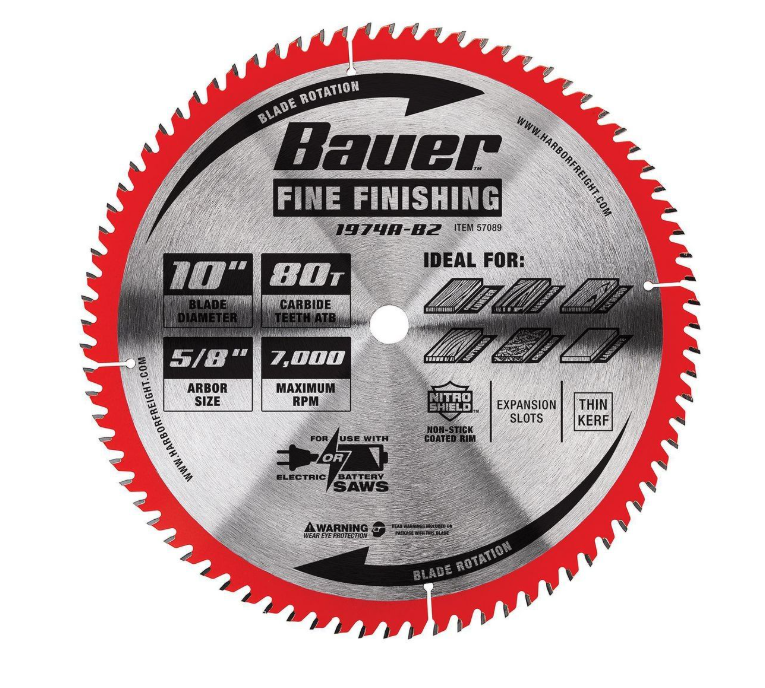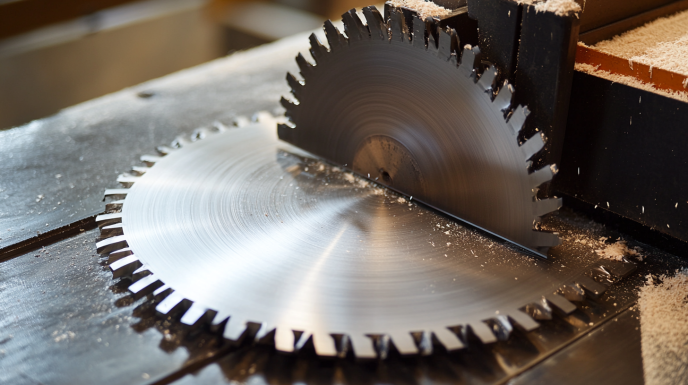
BAUER 10 in., 80T Fine Finishing Circular Saw Blade
- Thin kerf with Nitro Shield™ non-stick coating produces fast, flawless cuts
- Construction grade C3 carbide for performance and durability
- Super sharp cutting edges produce clean, smooth cuts every time
- Expansion slots prevent blade warp from overheating
- Ideal for corded or cordless saws
Discovering the Intricate World Where Tradition Meets Innovation
In the realm of artisanal craftsmanship, few names evoke the sense of heritage and quality quite like Bauer Fine. As I stepped into their sunlit studio in downtown Portland last month, the rich scent of oiled wood and polished metal created an immediate sensory connection to generations of craftsmanship. This wasn’t just another high-end boutique—it was a living workshop where the timeless tradition of handcrafted excellence continues to thrive in our mass-produced world.
The story of Bauer Fine is one that deserves to be told in full—from its humble beginnings to its current status as a cornerstone of American craftsmanship. It’s a narrative about people, passion, and an unwavering commitment to quality that has withstood the test of time. Let me take you on a journey through the fascinating world of Bauer Fine, exploring what makes this institution so special and why its reputation continues to grow among those who truly appreciate fine craftsmanship.
The Essence of Bauer Fine: Company, Concept, or Something More?
Newcomers to the world of artisanal goods often ask the most fundamental question: what exactly is Bauer Fine? The answer isn’t as straightforward as one might expect. Bauer Fine represents both a company and a philosophy—a dedicated group of master craftspeople and their commitment to exceptional quality.
At its core, Bauer Fine is a family-owned enterprise specializing in handcrafted luxury goods, primarily focusing on furniture, home accessories, and select leather goods. Yet to reduce Bauer Fine to merely a company would be to miss its essence. The term “fine” in their name isn’t just descriptive—it’s declarative. It represents their uncompromising standards and attention to detail that has become increasingly rare in today’s fast-paced manufacturing landscape.
“We’re not just creating products; we’re preserving a tradition of craftsmanship,” explains Marcus Bauer, the fourth-generation steward of the family business. “When someone purchases a Bauer Fine piece, they’re not just buying an object—they’re investing in a story, a process, and a piece of American crafting heritage.”
The Faces Behind the Craftwork: Who is Bauer Fine?
The Bauer family has been at the helm of this enterprise since its inception in 1897, when German immigrant Heinrich Bauer established a small woodworking shop in Portland, Oregon. Today, the company remains firmly in family hands, led by siblings Marcus and Elise Bauer, who represent the fourth generation of Bauer craftsmanship.
What distinguishes Bauer Fine from many contemporaries is their dedication to maintaining a close-knit team of artisans. Unlike larger luxury brands that have shifted toward mass production, Bauer Fine employs just twenty-seven craftspeople, many of whom have been with the company for decades. Each artisan specializes in specific techniques, having completed the company’s rigorous five-year apprenticeship program.
“Our people are everything,” Elise Bauer emphasized during my visit. “Each piece that leaves our workshop bears the invisible signatures of multiple craftspeople who have touched it throughout the creation process. That human connection is what makes a Bauer Fine piece truly special.”
The company culture reflects this human-centered approach. Walking through their workshop, I noticed the absence of assembly lines. Instead, individual craftspeople worked at stations arranged to facilitate collaboration while allowing space for concentration. The atmosphere wasn’t rushed but rather focused—each person deeply engaged with their materials in a dance of creation that has remained largely unchanged for generations.
The Specialization of Excellence: What Does Bauer Fine Create?
Bauer Fine has strategically resisted the temptation to diversify too broadly, instead focusing on perfecting specific categories of goods where their craftsmanship can truly shine. Their reputation has been built primarily on three pillars:
Fine Furniture: The cornerstone of Bauer’s reputation remains their handcrafted furniture, particularly their dining tables, sideboards, and bedroom pieces. Each item is created from sustainably sourced hardwoods, with black walnut, cherry, and maple being their signature materials. What distinguishes their furniture is the joinery—Bauer pieces famously use minimal metal fasteners, instead relying on traditional dovetail, mortise and tenon, and finger joints that become stronger over time.
Home Accessories: Building on their woodworking expertise, Bauer Fine produces limited collections of home accessories, including hand-turned wooden vessels, custom picture frames, and their celebrated kitchen implements. Their cutting boards and serving trays have developed a cult following among professional chefs and serious home cooks alike.
Select Leather Goods: A more recent addition to their repertoire, Bauer Fine’s leather collection emerged from a collaboration with a master leatherworker in 2003. Today, they create a small but exquisite range of leather goods, including journals, portfolios, and desk accessories that complement their wooden creations.
What ties these diverse items together is a unified aesthetic that Marcus Bauer describes as “elegant functionality.” There’s nothing ostentatious about Bauer Fine pieces—they don’t shout for attention but rather invite appreciation through use and subtle details that reveal themselves over time.
The Price of Perfection: Understanding Bauer Fine’s Value Proposition
Perhaps the most common question about Bauer Fine products relates to their cost. With dining tables starting at $8,500 and their signature leather portfolios commanding $450, Bauer Fine products unquestionably occupy the luxury tier of handcrafted goods.
“We’re transparent about our pricing,” Marcus explains. “When you purchase a Bauer Fine piece, approximately 60% of that cost goes directly to the hands that created it—the wages of our craftspeople who spend dozens or sometimes hundreds of hours on a single item.”
The remaining costs are divided between premium materials (Bauer exclusively uses highest-grade woods and leathers), operational expenses of maintaining their Portland workshop, and the company’s commitment to sustainability practices that often exceed industry standards.
This leads to the inevitable question: Is Bauer Fine worth the investment? The answer depends entirely on what the purchaser values. For those seeking disposable, trend-driven pieces, Bauer Fine would be an impractical choice. However, for those who appreciate the intersection of functionality, artistry, and longevity, Bauer Fine represents something increasingly rare—objects created with the intention of serving generations, not seasons.
“We have customers who come in with Bauer pieces their grandparents purchased,” Elise notes. “They’re not bringing them for repair—they’re bringing them to show us how beautifully they’ve aged and to add matching pieces to their collection. That’s the true measure of value.”
The Historical Journey: Tracing Bauer Fine Through Time
The story of Bauer Fine is inextricably linked to the broader narrative of American craftsmanship. Heinrich Bauer’s original workshop opened during a time when skilled handiwork was still the norm rather than the exception. What distinguished his approach was a fusion of European training with American materials and sensibilities.
The company weathered significant challenges through the decades. During the Great Depression, when luxury purchases evaporated almost entirely, the workshop pivoted to repair work and smaller gift items to sustain their craftspeople. During World War II, they temporarily shifted to producing specialized wooden components for military equipment, maintaining their skilled workforce while contributing to the war effort.
The post-war boom brought renewed interest in fine furnishings, and under the leadership of second-generation Thomas Bauer, the company expanded their repertoire and workshop size. However, the most significant test came during the 1970s and 1980s, when overseas mass production and changing consumer preferences pushed many American craftspeople to the brink of extinction.
“That was our crucible moment,” Marcus acknowledges. “My parents faced enormous pressure to either scale up production, outsource to cheaper facilities, or close entirely. Instead, they chose a fourth path—to double down on what made Bauer unique: uncompromising quality and direct relationships with clients.”
This decision to remain deliberately small and focused proved prescient. By the early 2000s, a renewed interest in artisanal goods and sustainable consumption created a renaissance for companies like Bauer Fine. Today, their waitlist for custom dining tables stretches to nine months, despite their premium pricing.
Beyond Products: The Bauer Fine Philosophy
What truly distinguishes Bauer Fine goes beyond their physical creations—it’s their philosophy toward craftsmanship and commerce that sets them apart. Unlike many luxury brands that rely heavily on marketing and exclusivity, Bauer Fine has built their reputation almost entirely through word-of-mouth and the intrinsic quality of their work.
Their approach to sustainability predates the term becoming a marketing buzzword. Since the 1950s, the company has maintained relationships with small, family-owned forestry operations within 300 miles of their workshop. They purchase entire logs rather than pre-cut lumber, allowing them to control the milling and drying process—a time-consuming approach that results in more stable, beautiful wooden components.
Similarly, their approach to leather sourcing involves direct relationships with tanneries that practice vegetable tanning rather than cheaper chrome methods. These practices increase costs but align with the company’s ethos of creating objects that are as ethically produced as they are beautiful.
The Misconceptions: Clarifying Common Questions
Throughout my research on Bauer Fine, I encountered several common misconceptions that deserve clarification:
Is Bauer Fine related to Bauer Tools? Despite the name similarity, Bauer Fine has no connection to the Bauer tool line sold through Harbor Freight. The similarity in names has occasionally created confusion, particularly online.
Are there fines associated with Bauer products? Some consumers searching online have confused the term “fine” in the company name with potential penalties or fees. To be clear, “fine” in this context refers to the quality and craftsmanship of the products, not any financial penalties.
Is Bauer Fine Art a separate entity? While Bauer Fine occasionally collaborates with artists for limited edition pieces, “Bauer Fine Art” is not a separate division or company. Their primary focus remains functional objects rather than purely decorative art.
Are there lawsuits involving Bauer Fine? Unlike some luxury goods companies, Bauer Fine has maintained a remarkably clean legal record throughout its history. They’ve never been involved in significant litigation beyond standard business matters.
The Customer Experience: From Commission to Creation
Purchasing a Bauer Fine piece isn’t simply a transaction—it’s an experience that often begins with a consultation at their Portland showroom or through their limited number of partner galleries in Seattle, San Francisco, Chicago, and New York.
For significant pieces like dining tables or bedroom sets, customers typically engage in a commissioned process. This begins with an in-depth conversation about not just dimensions and aesthetics but how the piece will be used, the environment it will live in, and the client’s broader design sensibilities.
“We’re not just selling furniture; we’re helping create spaces where life happens,” explains Elise, who oversees most client consultations. “I need to understand if this table will host formal dinner parties, help children with homework, or serve as a family gathering place for generations. Each of those needs influences the design.”
Following the initial consultation, clients receive detailed sketches and material samples. Once approved, production begins—a process that typically takes between three and seven months depending on the complexity of the design and the current workshop schedule.
What distinguishes this process from other custom furniture makers is the level of client involvement. Customers receive progress updates with photographs throughout the creation process and are invited to visit the workshop at key stages if geography permits.
The Materials That Make the Difference
A discussion of Bauer Fine would be incomplete without examining the materials that form the foundation of their work. Their material selection philosophy can be summarized in three principles: highest quality, ethical sourcing, and appropriate selection for each specific use.
Their wood selection has become increasingly deliberate over the decades. While many manufacturers rely on whatever is trending in interior design, Bauer maintains relationships with specific forestry operations to source black walnut, cherry, maple, oak, and occasionally more exotic species when they can be verified as sustainably harvested.
Perhaps most distinctive is their approach to material preparation. All wood used in Bauer pieces is air-dried for a minimum of two years before kiln drying—a time-intensive process that results in more stable lumber with richer coloration. This approach is nearly unheard of in modern furniture production but contributes significantly to the longevity of their pieces.
For their leather goods, Bauer works exclusively with vegetable-tanned full-grain leathers from two tanneries—one in Pennsylvania and one in Tuscany. These leathers develop a distinctive patina over time, essentially improving with age and use rather than deteriorating.
Hardware elements—the hinges, pulls, and mechanisms—are sourced from specialized producers in the United States and Germany, often custom-made to Bauer’s specifications. These seemingly minor components are crucial to the functionality and longevity of fine furniture.
The Critical Reception: How Experts View Bauer Fine
Within the world of fine craftsmanship, Bauer Fine has earned consistent praise from design critics, woodworking experts, and interior designers. Their pieces have been featured in architectural publications and design anthologies, typically highlighted for their balanced integration of traditional craftsmanship with subtly contemporary design sensibilities.
Professional woodworkers particularly praise the joinery techniques employed in Bauer furniture. Master craftsman and author Peter Korn described their work as “representing the pinnacle of traditional joinery executed with modern precision” in his 2018 survey of American furniture makers.
Interior designers frequently recommend Bauer pieces to clients seeking “forever furniture”—investment pieces that serve as anchors in a home’s design story. Designer Eleanor Hayes notes, “When I place a Bauer dining table in a project, I know it will still be there, still looking beautiful, when the surrounding décor has been refreshed multiple times.”
The most telling endorsement, however, comes from competitors. Other fine furniture makers often cite Bauer as a benchmark for quality and business practices. As one East Coast furniture maker confided, “When we’re debating a production method or material choice, someone will inevitably ask, ‘What would Bauer do?’ That’s the level of respect they’ve earned.”
Bauer Fine in the Digital Age: Accessibility and Online Presence
For a company rooted in traditional craftsmanship, Bauer Fine has navigated the digital transformation with remarkable thoughtfulness. Their online presence reflects the same restraint and quality as their physical products.
Their website serves primarily as a portfolio and educational resource rather than an e-commerce platform. While smaller accessories can be purchased directly online, their signature furniture pieces require the consultation process that begins either in person or through video conferencing.
“We’ve resisted pressure to fully digitize the purchasing process,” Marcus explains. “Creating fine furniture is inherently physical—the weight of the wood, the texture of the finish, the precision of the joinery. These qualities don’t translate to a purely digital experience.”
That said, Bauer Fine has embraced technology where it enhances rather than diminishes their craft. They use sophisticated 3D modeling software to test joinery methods before cutting into precious materials. Their inventory and client management systems are fully digital, allowing them to track the provenance of every piece of wood in their stockroom and maintain relationships with clients who often return for additional pieces years later.
The Future of Bauer Fine: Innovation Within Tradition
As our conversation drew to a close, I asked Marcus and Elise about the future of Bauer Fine. Their vision balances preservation of their heritage with thoughtful evolution.
“We’re constantly refining our craft,” Marcus notes. “While the fundamental techniques we use would be recognizable to my great-grandfather, we’re always seeking to improve our processes and designs. The goal isn’t to change for change’s sake but to ensure that Bauer remains relevant while staying true to our values.”
One area of innovation is their approach to sustainability. The company recently installed a solar array that provides approximately 40% of their workshop’s energy needs. They’ve also developed a closed-loop finishing system that significantly reduces chemical usage and waste in their finishing processes.
On the product side, Bauer has begun incorporating more mixed-material approaches—pairing wood with leather, metal, or stone in ways that highlight the natural beauty of each material. This evolution reflects changing aesthetic preferences while maintaining their commitment to craftsmanship.
Perhaps most significant is their investment in the next generation of craftspeople. The Bauer workshop now includes a dedicated training space where apprentices learn alongside master craftspeople, ensuring the transmission of techniques that cannot be learned from books or videos alone.
The Bauer Fine Experience: Worth the Investment?
After spending time with the Bauer family and their craftspeople, examining their work up close, and speaking with several long-time customers, I’ve developed my own perspective on the ultimate question: Is Bauer Fine worth the premium price?
For those seeking merely functional objects or following fast-changing trends, probably not. Bauer Fine operates in a different paradigm—one where objects are created to last generations, to develop character with use, and to connect their owners to a tradition of craftsmanship that predates our disposable culture.
What you’re investing in with a Bauer Fine piece goes beyond the physical object. You’re supporting a model of production that treats both materials and people with respect. You’re participating in a tradition of craftsmanship that connects past and future. And you’re choosing to surround yourself with objects that were made with intention and care.
In an age of endless consumption and disposability, there’s something profoundly countercultural about investing in objects created to last lifetimes. Bauer Fine doesn’t just sell furniture or accessories—they offer a different relationship with the material world, one based on quality, longevity, and appreciation rather than constant replacement.
As I ran my hand across the silky-smooth surface of a cherry wood sideboard before leaving the workshop, feeling the perfect mitered corners and the subtle hand-shaped curve of the drawer pull, I understood what truly separates Bauer Fine from most contemporary goods: these objects don’t just serve a function—they tell a story, carry a legacy, and invite us to appreciate the beauty of things well-made.
For those who value these qualities, a Bauer Fine piece isn’t an expense—it’s an inheritance in the making.

